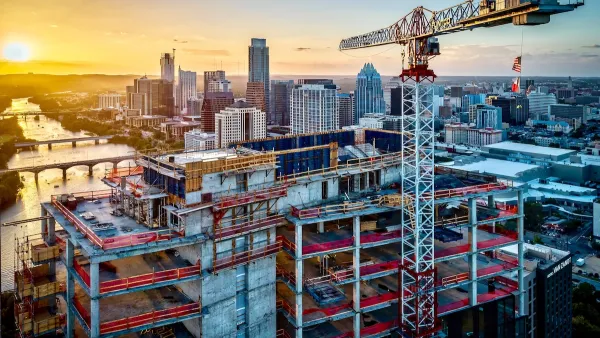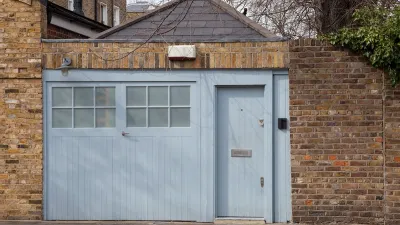A top priority of Lt. Gov. Dan Patrick, the legislation would make it easier to construct homes on smaller lots. A House Democrat briefly killed the bill.

This article by Joshua Fechter was originally published in The Texas Tribune, a nonprofit, nonpartisan media organization that informs Texans — and engages with them — about public policy, politics, government and statewide issues.
A proposal to allow smaller homes on smaller lots in Texas cities — part of a slew of bills intended to tame the state’s high home prices and rents — is back from the dead after a procedural move killed it in the Texas House Sunday.
Senate Bill 15 — a top priority of Lt. Gov. Dan Patrick, who leads the Senate — would reduce the amount of land cities require for single-family homes in new subdivisions. That would give homebuilders the flexibility to build smaller homes on less land, reducing the final cost of the home.
The bill, which has already cleared the Senate, briefly came before the Texas House Sunday afternoon before state Rep. Ramon Romero Jr., D-Fort Worth, moved to kill the bill on procedural grounds. That move prevailed. But in a sigh of relief for housing advocates, lawmakers resurrected the bill hours later, fast-tracking the bill to come back before the chamber Tuesday.
“It’s one of the best opportunities we have in this state to make housing affordable,” State Rep. Gary Gates, a Richmond Republican who carried the bill in the House, said of the bill.
In a further victory for housing advocates, the Senate on Sunday approved House Bill 24, a priority for House Speaker Dustin Burrows. It aims to make it more difficult for property owners to block new housing. The House must sign off on changes made in the Senate before it can make its way to Gov. Greg Abbott’s desk.
Some city officials as well as neighborhood activists who oppose new housing balked at the idea of the tiny homes bill, arguing the proposal would be an undue incursion on cities’ ability to say what kinds of housing can be built and where.
The bill included narrow language designed to prevent it from taking effect within a mile of a police training center in Dallas County. Romero raised the proposal to kill the bill, stating that language was out-of-bounds. The proposal was upheld, preventing the House from further discussing the bill. Gates said Sunday evening that language had been changed to avoid the same fate when it hits the House floor Tuesday.
Romero, a former member of Fort Worth’s city planning and zoning boards, said he wasn’t comfortable with the state weighing in on local rules that say how much land single-family homes must sit on. He also had concerns about whether homes allowed under the bill would create nuisances, such as runoff and traffic, for existing residents.
Romero, who owns a business that does residential masonry work, said he also wasn’t convinced that the bill would result in lower home prices, pointing to pricier homes built in recent years on smaller lots in Austin.
“It's already been proven that just because you have smaller (homes) does not immediately equate to more affordable (homes),” Romero said in an interview. “So if the argument is that that's what it is, then I'd say, show it to me.”
Allowing smaller homes on less land in Texas has generally been associated with lower home prices. Beginning in the late ‘90s, Houston reduced how much land the city requires single-family homes to sit on. Those reforms resulted in tens of thousands of new homes built on smaller lots, and housing advocates and researchers have credited that building boom with helping to keep the city’s home prices in check, especially when compared to other major U.S cities. Those homes tended to have lower values than traditional single-family homes on larger lots, research from New York University’s Furman Center for Real Estate and Urban Policy shows.
The bill seeks to reduce the ultimate cost of a home by reducing how much land homebuyers would be required to purchase. Building smaller homes on smaller lots would also allow more homes to be built overall — chipping away at the state’s housing shortage, a key driver of the state’s high housing costs, the bill’s proponents argued.
“When a single legislator kills a bill that would help Texans find an affordable place to live, it’s not just out of touch, it’s a slap in the face to hardworking families trying to stay afloat,” said Nicole Nosek, who chairs Texans for Reasonable Solutions, a group that has pushed several housing bills this session.
Major cities in Texas tend to require single-family homes to sit between 5,000 and 7,500 square feet of land, according to a Texas Tribune analysis. The bill would bar cities from requiring homes in new subdivisions to sit on more than 1,400 square feet. That provision wouldn't apply in existing neighborhoods, and new subdivisions would have to sit on at least five acres of land.
Given higher home prices and high interest rates, reducing the amount of land is necessary to give would-be homebuyers a path to homeownership, Gates said.
“If you’re in a house that you bought a number of years ago, life looks good to you,” Gates said of the bill’s opponents. “We don’t live in that world anymore.”
The proposal is part of a package of GOP bills aimed at reining in the state’s high home prices and rents by allowing more homes to be built. Texas builds more homes than any other state but not enough to keep up with demand amid the state’s population boom.
The state needs 320,000 more homes than it has, according to an estimate by the housing advocacy group Up For Growth. As a result, home prices and rents have skyrocketed, housing advocates and experts say.
Lawmakers this year have advanced proposals aimed at reducing red tape and local regulations to let more homes be built. Legislators have pushed bills to allow apartments and mixed-use developments along retail and commercial corridors and additional dwelling units in the backyards of single-family homes.
They’ve also pushed legislation to make it harder for landowners to stop new homes from being built near them and to allow homebuilders to more quickly obtain city building permits. None of those bills has yet reached the governor’s desk.
Not every city would have to abide by every change lawmakers intend to make on the housing front. Bills to allow tiny homes on small lots and homes along commercial corridors, for example, would only apply to cities with at least 150,000 residents in counties with a population of 300,000 or more.
That means those bills would only apply to 19 of the state’s largest cities, according to a Tribune analysis of U.S. Census Bureau data. Excluded are major cities like Laredo, Amarillo, Waco, College Station, Midland and Odessa; suburbs like Round Rock and New Braunfels; and wealthy enclaves like Westlake, Highland Park, University Park and Olmos Park.
House lawmakers are expected to take up other housing affordability bills Sunday. Those bills aim to make it easier to convert vacant office buildings into residences and encourage the construction of smaller apartments. They also would bar cities from outlawing manufactured homes and relaxing rules in college towns that restrict how many unrelated adults can live in a home.
On Monday, the House is scheduled to take up a bill aimed at making it easier to build accessory dwelling units in the backyards of single-family homes.
Correction, May 26, 2025 at 12:07 p.m.: A previous version of this story incorrectly stated that Senate Bill 15 would apply to existing neighborhoods. It would only apply to new subdivisions.
The Texas Tribune is a member-supported, nonpartisan newsroom informing and engaging Texans on state politics and policy. Learn more at texastribune.org.
FULL STORY: Bill to allow smaller homes on smaller lots resurrected in Texas House

Maui's Vacation Rental Debate Turns Ugly
Verbal attacks, misinformation campaigns and fistfights plague a high-stakes debate to convert thousands of vacation rentals into long-term housing.

Planetizen Federal Action Tracker
A weekly monitor of how Trump’s orders and actions are impacting planners and planning in America.

In Urban Planning, AI Prompting Could be the New Design Thinking
Creativity has long been key to great urban design. What if we see AI as our new creative partner?

California Creates Housing-Focused Agency
Previously, the state’s housing and homelessness programs fell under a grabbag department that also regulates the alcohol industry, car mechanics, and horse racing.

Chicago’s Ghost Rails
Just beneath the surface of the modern city lie the remnants of its expansive early 20th-century streetcar system.

Baker Creek Pavilion: Blending Nature and Architecture in Knoxville
Knoxville’s urban wilderness planning initiative unveils the "Baker Creek Pavilion" to increase the city's access to green spaces.
Urban Design for Planners 1: Software Tools
This six-course series explores essential urban design concepts using open source software and equips planners with the tools they need to participate fully in the urban design process.
Planning for Universal Design
Learn the tools for implementing Universal Design in planning regulations.
planning NEXT
Appalachian Highlands Housing Partners
Mpact (founded as Rail~Volution)
City of Camden Redevelopment Agency
City of Astoria
City of Portland
City of Laramie





























